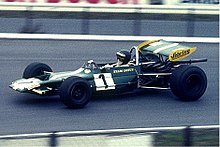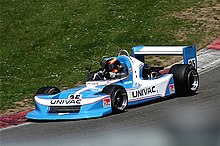Formula 2
The Formula 2 is a racing category for single-seater open racing cars. It was advertised for the first time in 1947 as a substructure for Formula 1 and as the successor class to the Voiturette class that was common before the Second World War . Until the 1980s there were various regional championships in this class, including the Formula 2 European Championship . It was replaced from 1985 onwards by the Formula 3000 and later the GP2 series , the regulations of which differed significantly from the original Formula 2. With the start of the 2017 season , the term Formula 2 will be used internationally again; the previous GP2 series was named FIA Formula 2 Championship .
Formula 2 from 1950 to 1984

History and regulations
In addition to individual races, which were not combined in any championship, there were national championships, but only from 1967 a European championship. However, the drivers' world championships in 1952 and 1953 were held temporarily according to the Formula 2 regulations , as not enough competitive Formula 1 cars were available after Alfa Romeo's withdrawal .
The rules changed over time. From 1947 to 1953 there was an upper displacement limit of 2000 cm³ (or 500 cm³ for compressor-powered vehicles). With the introduction of the new Formula 1 capacity limit of 2500 cm³ for the 1954 season, the previous Formula 2 was also dropped. It was not until 1957 that a new Formula 2 was officially introduced with a capacity limit of 1500 cm³ and a restriction to six cylinders.
In 1961, these Formula 2 rules were raised to Formula 1 with the abolition of the limitation on the number of cylinders, whereby previous Formula 2 vehicles such as the Porsche 718 or Ferrari 156 were automatically included in Formula 1. Formula 2 was reintroduced in 1964, with the regulations stipulating a displacement limit of 1000 cm³ and a minimum weight of 420 kg.
In 1967 the FIA introduced the Formula 2 European Championship , which lasted until 1984. The displacement was increased to 1600 cm³. These vehicles with over 200 hp were allowed to compete at the Nürburgring at the same time as Formula 1 due to the length of the track to fill the starting field and were even able to leave some of the heavier Formula 1 cars behind. In addition, many Formula 1 drivers also competed in pure Formula 2 races, but where they were not eligible for EM points. Sun won Jochen Rindt Formula 2 race number, but could the same opponents in Formula 1 because of its mostly inferior vehicles for many years not beat. The two-time Formula 1 world champion Jim Clark died in a Formula 2 race at the Hockenheimring , as well as the German Gerhard Mitter , who during practice for the Grand Prix of Germany 1969 in the plant - BMW F269 crashed.
From 1972, 2000 cc and six cylinders were again the upper limit. Until 1975, a minimum number of units (100 to 1000) had to have been built in the last year of the engine type. From 1976 pure racing engines with an output of over 300 hp were permitted. At the beginning of the 1980s, it achieved lap times on the Nürburgring that corresponded to those of Formula 1 in the mid-1970s.
Hannelore Werner was the only woman to achieve a podium position at the Nürburgring in 1970 .
1985 Formula 2 was the Formula 3000 replaced, in which the Cosworth DFV - naturally aspirated engines continued to be used, which were by the introduction of turbos no longer competitive in Formula 1 and thus low standing in large numbers are available.
In 2005 the successor series of the Formula 3000 was introduced, the GP2 series , in which uniform V8 engines with 4000 cc were used for reasons of reliability. Curiously enough, the "small class" initially had more cubic capacity than Formula 1.
Championships and racing series
Championships
According to the Formula 2 regulations, various championships have been held over the years:
- Formula 2 European Championship ( 1967 to 1984 )
- Japanese Formula 2 Championship (under this name from 1977 to 1986; previously known as Japanese Formula 2000 Championship)
- British Formula 2 Championship (1956–1960, 1964 to 1967, 1972). Separate from this are the British Formula 2 championships from 1992 to 1996: These were the successors to the British Formula 3000 championship (1989 to 1991), which, regardless of their (insofar misleading) name, are still subject to the current regulations of the Formula 3000 was the basis.
- Trophées de France (1964 to 1967)
- Italian Formula 2 Championship
- Swiss Formula 2 Championship (1971)
There were also other Formula 2 championships in Australia and Mexico. However, they were based on an independent technical regulation.
Regional Formula 2 series
In addition to the championships, there were at times various racing series without championship status according to Formula 2 regulations. These include
- the Colombian Formula 2 Series (two races in 1971)
- Torneio Brasiliero Formule 2 (four races in December 1971 in Brazil and Argentina).
Revival 2009–2012
After the revival of Formula 2 had been discussed for a long time, the British ex-Formula 1 driver Jonathan Palmer was awarded the contract to create a new Formula 2 series in 2008 . From 2009 the FIA Formula 2 Championship was held. The concept looked like this:
- For cost reasons, standard cars drove in this series.
- For the same reason, there were no teams in the traditional sense.
- For reasons of equal treatment, the mechanics worked for a different driver at each race.
- The Formula 1 designer Williams designed the chassis.
- The 1.8-liter turbo engines came from Audi ; their output was around 300 kW.
The regulations were thus very similar to the restrictive variant in the one-make cup. In 2009 ten races were held, some of them as part of the WTCC touring car championships . The series was discontinued at the end of the 2012 Formula 2 season .
FIA Formula 2 Championship
From the 2017 season, the GP series was continued under the name FIA Formula 2 Championship . The regulations correspond to those of the previous GP2 series. It has no relation to Formula 2 from 1950 to 1984.
Web links
- www.formula2.net ( Memento from June 26, 2017 in the Internet Archive )
- Official Site of the new Formula 2 (English)
Individual evidence
- ↑ Marcus Simmons: GP2 Series becomes new FIA Formula 2 Championship. Autosport.com, March 9, 2017, accessed March 10, 2017 .




